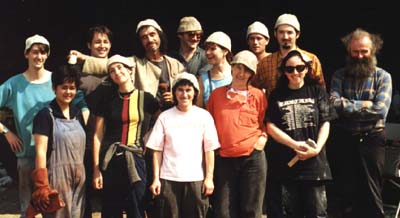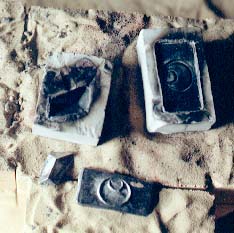|
UMHA AOIS '96 After driving for nine hours from Kerry to Armagh I arrived at the Benburb Hostel just as Niall O'Neill and John O'Malley were heading off to explore "Ted's Farm" with artists in tow, not content to leave things until the morning. This was to set the pace for the following ten days of non-stop work (and play!).
The first nights' exploration turned out to be the first day's work and after that the week is quite a blur! Umha Aois: The Experimental Bronze Age Casting Project was hosted by the Navan Centre, with the main work area being Ted Loughran's farm nearby. Ted gave us free run of his farm buildings, land and his huge collection of tools -- which were the envy of every sculptor there! The Navan Centre opened its doors to us as a resource centre, allowing free access to the fantastic displays and knowledgeable staff. James McKee, the education officer, seemed to be an endless font of archaelogical, geographical, historical, and Celtic mythological information! The objective of the project was to reproduce and celebrate the various casting processes practised during the Bronze Age, mainly using stone moulds and clay moulds. With the expert assistance of Laura O'Hagan for the clay work, Adam Howlin in the stone department and Niall O'Neill looking after the bronze and the furnace, everyone was able to get their hands dirty regardless of their individual experience. A modern furnace was provided to ensure that casting could be done whenever a mould was ready.
Each artist was also asked to produce a bronze marker to be sited around Armagh city in commemoration of the project, and to facilitate this, sand-casting equipment was available and much used. Vivienne Hansbury reassured us all that the sand-casting equipment wouldn't bite so that even I, who hadn't worked with it since 1989, by the end of the week, felt again like a veritable expert. Hats off to Vivienne's patina assembly line and the beautiful finishes which were produced! Laura showed us how to mix different types of clay, experimenting with added ingredients such as flax and wool to create a porous mixture which would allow gasses to escape when the bronze was poured into such a mould. If you want your clay to come out of the kiln like concrete, try cow-shit -- the Umha Aois secret ingredient! Archaeological evidence suggests that in the Bronze Age casting was sometimes done in delicate "sandwiches" of two-piece clay moulds. During the project, this technology was reproduced by the artists whose delicate moulds proved to be more durable than they looked: after the bronze was poured, they opened to reveal that all the details had registered and the moulds themselves were still in good condition (and probably could have been reused if we had had the time). Time, however, was passing very quickly that week. Another clay mould approach was shown to us by Peju Laywola, an artist from Benin, Nigeria. This involved a lost-wax approach, with a central solid core mould held in place by pins attached to the outer mould. The ancient Celts used a similar pins-to-core approach when creating their ceremonial trumpets and other hollow objects. The pins insure that the the core does not shift during the pour. The problems encountered with this method were a result of geography -- this being Ireland not Africa. In Africa's dry heat the moulds would have dried in an afternoon; we had to resort to carefully cooking them near the furnace and then into the kiln. As before, various clays were mixed and used with varying degrees of success -- most notably Dympna Molloy's mould which was poured at the last minute on the last day: when it cooled the mould cracked open like a walnut and the bronze bowl inside hardly had to be cleaned!
Adam was kept busy the whole week cutting sections of stone for moulds -- with an attentive audience of Ted's bulls. The stone moulds proved to be an exacting and unforgiving medium, but when the process was executed properly it gave excellent results. As the week progressed so did the sophistication of the moulds. As we learned more about the procedure, the participants were able to produce working one piece and two piece moulds from limestone, soapstone, and sandstone. What began as fracturing and exploding dissapointment ended with Adam and Padraig McGoran both producing working three-piece stone moulds of hollow shaft spearheads. While all this experimenting with moulds was going on, the participants were also constructing a bronze age furnace, aided by Niall's very authentic-looking drawings -- charcoal on some handy piece of wood or lines scratched out on the ground -- bronze age blueprints! Ted got it off to a fast start by excavating a suitable hole in the ground and then demonstrated his infamous "wattling" by constructing a wind-break all around the furnace site. The furnace ended up as an igloo-like affair constructed from clay and loaded with charcoal through an opening in the "roof". Laura created several small clay cauldrons, to hold the bronze, which were fired in the furnace when it was lit at the end of the week. As there was only time to fire up the furnace once, there was only one chance to see if it would work -- and we weren't disappointed: when a cauldron was extracted from the furnace and tipped over -- voila-- molten bronze! However, there was no time to celebrate as we were back to work! Everyone agreed that the project could easily have filled three weeks; the ten days we had were spent working at an increasingly frantic pace. But that is not to say we didn't have any fun, as work was well balanced with play... |
||||||||||
|


